List of assassinated and executed heads of state and government
The following is a chronological list of notable heads of governments and heads of state deaths have resulted from assassination or execution.
This list considers only the incumbent head of state or government.
List
Statistics
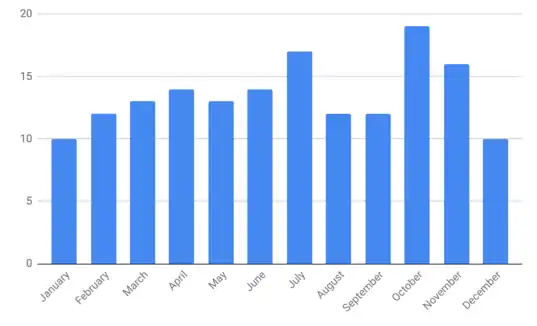
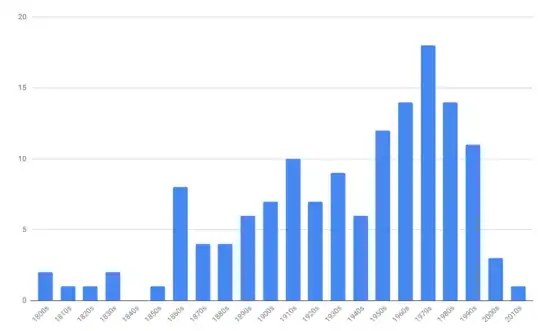
Gallery
.jpg.webp)
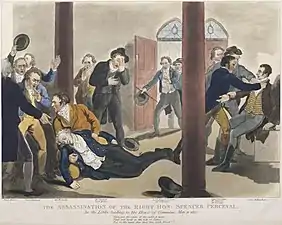
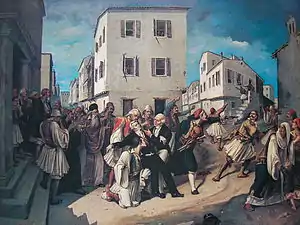
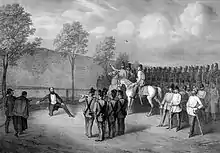
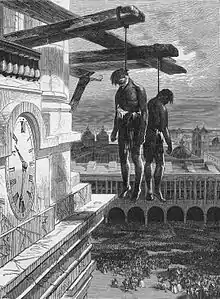



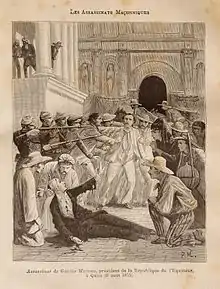
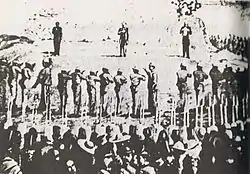

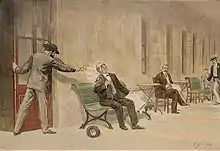
 Assassination of Willam McKinley on September 14, 1901, Pan-American Exposition, Buffalo, New York, United States
Assassination of Willam McKinley on September 14, 1901, Pan-American Exposition, Buffalo, New York, United States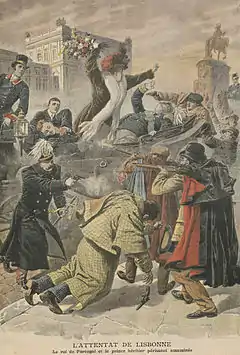



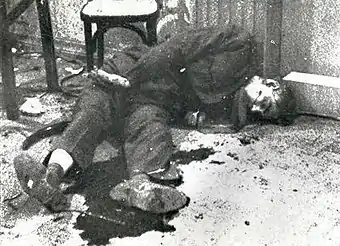

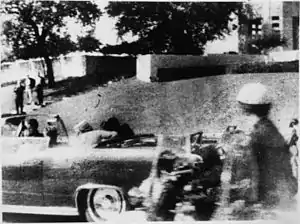
See also
- Ulla Koch-Westenholz (2000). Babylonian Liver Omens: The Chapters Manzazu, Padanu, and Pan Takalti of the Babylonian Extispicy Series Mainly from Assurbanipal's Library. Museum Tusculanum. p. 394.
- Chronicle P, column 4, lines 10 to 11.
- GIŠ.TUKUL.TA BA.AN.SÌG.GI.IN, “by the sword.”
- Dynastic Chronicle v 5-6: mdÉ-a-mu-kin-NUMUN LUGAL IM.GI DUMU mḪaš-mar iti 3 in.ak, ina raq-qa-ti šá É-mḪaš-mar qí-bir.
- J. A. Brinkman (1982). "Babylonia, c. 1000 – 748 B.C.". In John Boardman; I. E. S. Edwards; N. G. L. Hammond; E. Sollberger (eds.). The Cambridge Ancient History (Volume 3, Part 1). Cambridge University Press. pp. 296–297.
- Dionysius of Halicarnassus (1937). "Roman Antiquities vol II ch 51-52". doi:10.4159/DLCL.dionysius_halicarnassus-roman_antiquities.1937. Retrieved 13 November 2016. Cite journal requires
|journal=(help) – via digital Loeb Classical Library (subscription required) - Healy, Mark (1991). The Ancient Assyrians. London: Osprey. p. 17. ISBN 1-85532-163-7. OCLC 26351868.
- J. A. Brinkman (2001). "Nabû-nādin-zēri". In Erich Ebeling; Bruno Meissner; Dietz Otto Edzard (eds.). Reallexikon der Assyriologie und vorderasiatischen Archäologie: Nab-Nuzi. Walter de Gruyter. pp. 29–30.
- J. A. Brinkman (1984). Prelude to Empire: Babylonian Society and Politics, 747-626 B.C. 7. Philadelphia: Occasional Publications of the Babylonian Fund. p. 23.
- J. A. Brinkman (1984). Prelude to Empire: Babylonian Society and Politics, 747-626 B.C. 7. Philadelphia: Occasional Publications of the Babylonian Fund. pp. 42–43.
- Mark, Joshua J. (2014). "Sargon II". Ancient History Encyclopedia. Retrieved 9 February 2020.
- Bertman, Stephen (2005). Handbook to Life in Ancient Mesopotamia. OUP USA. p. 79. ISBN 978-0195183641.
- Simo Parpola (1980). "The Murderer of Sennacherib". Gateways to Babylon.
- Albertz, R.; Israel in exile: The history and literature of the sixth century BC; Society of Biblical Literature, Atlanta 2003, p.63 ISBN 1-58983-055-5.
- Livy, Ab urbe condita, 1.42, 1.46, 1.47.
- Herodotus 1920, Book V. 55
- Iran-e-Bastan/Pirnia book 1 p. 873
- S. Zawadzki, "The Circumstances of Darius II's Accession" in Jaarbericht Ex Oriente Lux 34 (1995-1996) 45-49
- Plutarch, Lives: Life of Dion. (About/Wikisource)
- Plut. Dion. 28-58
- Diodorus Siculus. "The Library of History". 16.91-95. Archived from the original on 4 March 2010.
- LeCoq, P. (1986). "Arses". Encyclopaedia Iranica, Vol. II, Fasc. 5. p. 548.
- "Seleucus I Nicator". Livius.
- The Mausoleum of Antiochus II Theos
- Han 2010, pp. 5132-5137.
- "Seleucus III Keraunos". Livius.org.
- Livy, 35.35
- Lahiri, B. (1974). Indigenous States of Northern India (Circa 200 B.C. to 320 A.D.) , Calcutta: University of Calcutta, pp.24-5
- "Seleucus IV Philopator". Livius.org.
- Diodorus 32.9d & 10.1; Zabdiel: I Maccabees 11.17; Josephus AJ 13.118.
- Makk. 13.31; Diod. Sic. 33.28; App. Syr. 68. 357; Iust. 36.1.7.; Oros. 5.4.18.
- Sallust, Bellum Jugurthinum 5, 9, 11, 12
- Diod. Exc. Vales. xxxv. p. 605
- Suetonius, Julius, c. 82.
- Josephus, Antiquities of the Jews XIX.1.3.
- cf. Tac. Ann. XII 66–67.
- Suet. Claud. 43
- Greenhalgh 1975, pp. 30, 37, 45, 47–54.
- Tacitus, Histories III.84, III.85
- Suetonius, Life of Domitian 14;16
- Cassius Dio, Roman History, Book LXXII, pg. 117.
- Lampridius, Historia Augusta. "Life of Commodus," pg. 306.
- Dio, 74:10
- Cassius Dio, lxxiv, 17.5; Historia Augusta, Didius Julianus, 8.8.
- Gibbon, Ibid. p. 115
- Goldsworthy, Adrian (2009). How Rome Fell: death of a superpower. New Haven: Yale University Press. pp. 74. ISBN 978-0-300-16426-8.
- Crevier, Jean Baptiste Louis (1814). The History of the Roman Emperors from Augustus to Constantine, Volume 8. F. C. & J. Rivington. pp. 236–237.
- Vagi 2000, p. 290.
- Bédoyère 2017, p. 236.
- Cassius Dio, Roman History LXXX.20
- Southern, Pat. The Roman Empire from Severus to Constantine, Routledge, 2001, p. 63
- Southern, Pat. The Roman Empire from Severus to Constantine, Routledge, 2001, p. 67
- Potter, David.S. The Roman Empire At Bay AD 180-392, Routledge, 2004, ISBN 0-203-67387-5, pg.234-238.
- Potter, David.S. The Roman Empire At Bay AD 180-392, Routledge, 2004, ISBN 0-203-67387-5, pg. 241
- Bowman, Alan K., The Cambridge Ancient History: The Crisis of Empire, A.D. 193-337, Cambridge University Press, 2005, pg. 38
- Potter, David.S. The Roman Empire At Bay AD 180-392, Routledge, 2004, ISBN 0-203-67387-5, pg. 252
- Historia Augusta, The two Gallieni, XIV.4–11
- Polfer, Michel (2000), "Postumus (A.D. 260-269)", De Imperatoribus Romanis
- Aurelius Victor 33.8; Eutropius 9.9.1
- Potter, David Stone, The Roman Empire at Bay, AD 180-395, Routledge, 2004, pg. 266
- Southern, Pat (2001). The Roman Empire from Severus to Constantine. Routledge. p. 119
- Meijer 2004, p. 103.
- Syvanne 2015, p. 172.
- Aurelius Victor, Epitome de Caesaribus, 37:4
- Southern, Patricia (May 15, 2015). The Roman Empire from Severus to Constantine. Routledge. p. 193. ISBN 9781317496946.
- Leadbetter, William. Carinus (283–285 A.D.).
- Panegyrici Latini 8:12; Aurelius Victor, Book of Caesars 39.40; Eutropius, Abridgement of Roman History 22; Orosius, Seven Books of History Against the Pagans 7:25.6
- Aurelius Victor, Epitome de Caesaribus, 41:21:23
- An Encyclopedia of World History, Ibid
- Gibbon, p. 960
- Ambrose, Patrologia Latina, Ep. 40.32
- Susan Wise Bauer, "The History of the Medieval World: From the Conversion of Constantine to the First Crusade", W. W. Norton & Company, 22 Feb 2010 (p.68)
- Historia nova, IV. 53 which relies heavily on the history by the pagan Eunapius
- Carr, John (2015). Fighting Emperors of Byzantium. Pen & Sword. pp. 40–43. ISBN 978-1783831166.
- Jones, Arnold Hugh Martin, John Robert Martindale, John Morris, The Prosopography of the Later Roman Empire, volume 2, Cambridge University Press, 1992, ISBN 0-521-20159-4, pg. 316
- Birley, Anthony (2005), The Roman Government in Britain, Oxford University Press, ISBN 978-0-19-925237-4 pg. 460
- Procopius, III.3.9; translated by Dewing, pp. 75ff
- Priscus of Panium 2015, p. 129.
- Aston, William. (1998). Nihongi, Vol. 1, pp. 328–333.
- John of Antioch, fragment 203; Marcellinus, sa 461; Fasti vindobonenses priores, No 588. Procopius (VII.14–15) does not mention the Emperor's return from Hispania and said that Majorian died of dysentery: it is possible that the news has been put about by Ricimer (Fik Meijer, Emperors Do not Die in Bed, Routledge, 2004, ISBN 0-415-31201-9, p. 155). Victor of Tonnena erroneously claims that Majorian reached Rome and was killed there, and puts this event in 463 (Chronica, s.a. 463).
- Cassiodorus, Chronicles, s.a. 465.
- Cassiodorus, Chronicle, 1293; Marcellinus Comes, Chronicon, s.a.472; Procopius of Caesarea, Bellum Vandalicum, vii.1–3. Chronica gallica anno 511 (n. 650, s.a. 472) records both versions.
- Fasti vindobonenses priores, n. 606, s.a. 472.
- Halsall, Guy (2007). Barbarian migrations and the Roman West, 376-568. Cambridge: Cambridge University Press. p. 282.
- Amory, Patrick (1997). People and Identity in Ostrogothic Italy, 489–554. Cambridge; New York: Cambridge University Press. ISBN 978-0-51152-306-9. pg. 69
- Wolfram, Herwig (1988). History of the Goths. Berkeley and Los Angeles: University of California Press. ISBN 0-520-05259-5. pg. 283
- Shahbazi, A. Sh. (1988). "Bahrām VI Čōbīn". Encyclopaedia Iranica, Vol. III, Fasc. 5. London et al. pp. 514–522.
- Ostrogorsky, G (March 1958). "G. Ostrogorsky: History of the Byzantine State". The Classical Review. 8 (1): 93–94. doi:10.1017/s0009840x00164169. ISSN 0009-840X.
- "Theophanes Continuatus". Encyclopedia of the Medieval Chronicle. doi:10.1163/9789004184640_emc_sim_02417. Retrieved 2020-11-28.
- http://denstoredanske.dk/Danmarks_geografi_og_historie/Danmarks_historie/Danmark_før_Reformationen/Erik_2._Emune
- http://www.roskildehistorie.dk/1100/billeder/krige/blodgilde/blodgilde.htm
This article is issued from Wikipedia. The text is licensed under Creative Commons - Attribution - Sharealike. Additional terms may apply for the media files.